Denmark’s geographic size may be modest, but its historical legacy is anything but.
Spanning millennia, the country’s story reaches from Viking conquest and medieval unions to modern-day democracy and global cooperation.
Through innovation, resilience, and reform, Denmark has continuously shaped and reshaped its national identity—and left a lasting impact on the world.
From fearsome Viking warriors to modern political reformers, the story of Denmark is one of transformation, resilience, and cultural influence. This article will guide you through the history of Denmark, tracing the key events that shaped the nation we know today.
The Beginnings: What Was Denmark Like in the Viking Age?
The Viking Age Denmark (roughly 800–1050 CE) is where much of Denmark’s early international presence was forged.
The Danes, along with Norwegians and Swedes, sailed across Europe, trading, raiding, and settling as far as England, Ireland, France, and even North America. Danish Vikings played a central role in establishing the Danelaw in England—a region under Scandinavian law.
One of the most famous Viking kings was Harald Bluetooth, who is credited with uniting Denmark and converting it to Christianity around the year 965. A modern-day tribute to Harald is the Bluetooth technology named after him, symbolizing unification.
Learn more about the Viking Age at The National Museum of Denmark
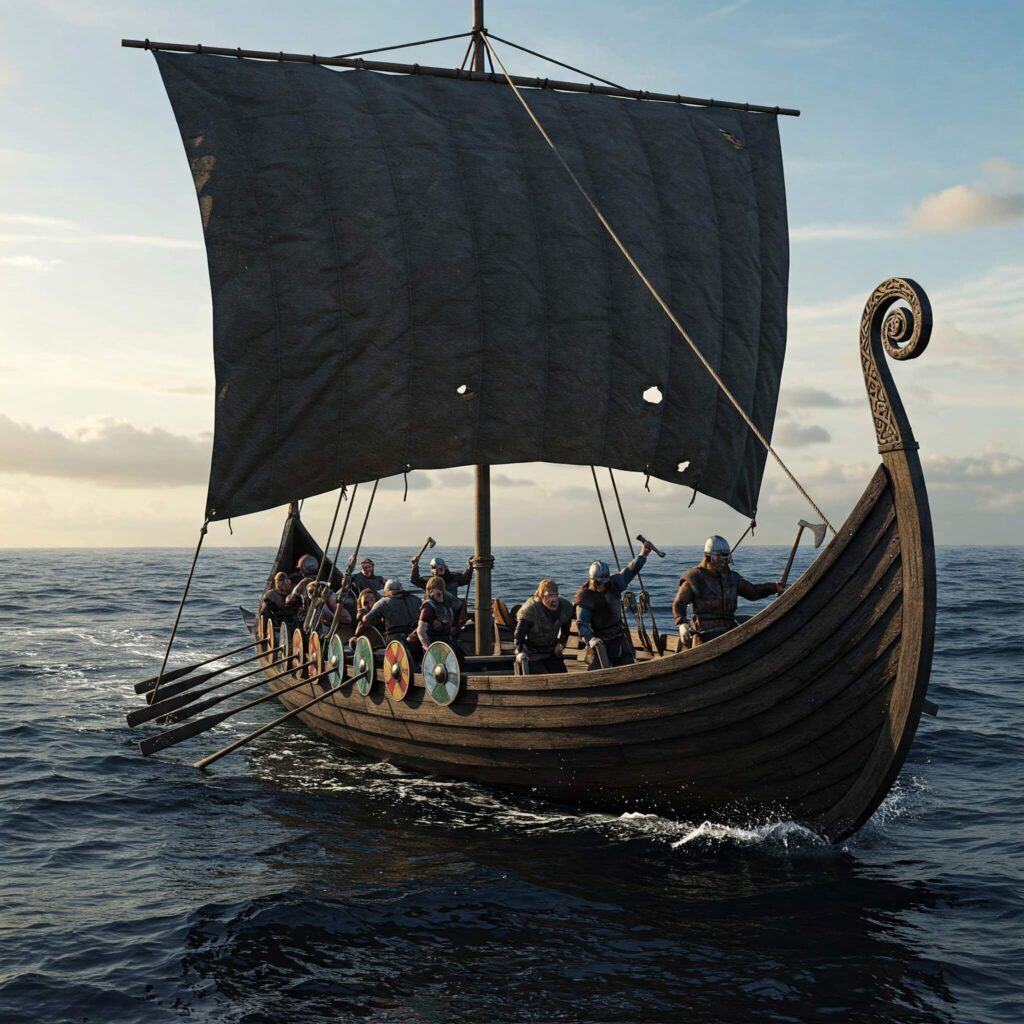
The Danish Monarchy and the Middle Ages
Following the Viking period, Denmark entered the Middle Ages. This period saw the consolidation of royal power and the Christian church. The Danish monarchy history dates back over 1,000 years, making it one of the oldest in the world.
Denmark was part of the Kalmar Union (1397–1523), a political alliance that united the crowns of Denmark, Norway, and Sweden under a single monarch. This was a high point for Danish royal influence but also a period of internal conflict and unrest.
During the Reformation in the 16th century, Denmark officially became a Lutheran state under King Christian III, and the crown gained control of church property. This period laid the foundation for a more centralized state.
You can explore a detailed Danish history timeline on the official website of Denmark.
From Absolute Monarchy to Constitutional Reform
From the 17th to the 19th century, Denmark was governed as an absolute monarchy. This meant the king had virtually unlimited power. However, this changed with the rise of democratic ideals across Europe.
In 1849, Denmark adopted its first constitution, marking the end of absolute rule and the beginning of Denmark’s government system as a constitutional monarchy. This was a monumental shift in Danish political history, introducing civil liberties and a parliamentary system.
The Danish royal family, though still symbolic today, no longer holds political power. Queen Margrethe II, Denmark’s current monarch, plays a largely ceremonial role.
Denmark and the World Wars
Denmark remained neutral during World War I but could not avoid conflict in the 20th century. In 1940, Nazi Germany invaded Denmark. Although the Danish government initially cooperated to avoid destruction, resistance grew over time.
One of the most notable Denmark historical events of World War II was the rescue of Danish Jews in 1943. With help from ordinary citizens, over 7,000 Jews were ferried to safety in neutral Sweden.
You can read more about this chapter in The Danish Resistance Museum.
How Denmark Became a Democracy
The post-war period saw Denmark fully embrace democratic principles. Danish social reforms in the 20th century included the expansion of the welfare state, free healthcare, and education, which are central to Danish identity today.
Denmark has also been a founding member of international organizations like the United Nations and the European Economic Community (now the EU). These steps solidified its place on the global stage.
Internally, the evolution of Denmark’s political system led to stable multi-party coalitions, and consensus-driven governance has become the norm.
Key Events in Denmark’s History: A Quick Overview
To better understand the Danish history timeline, here’s a colorful visual overview of Denmark’s key historical events:
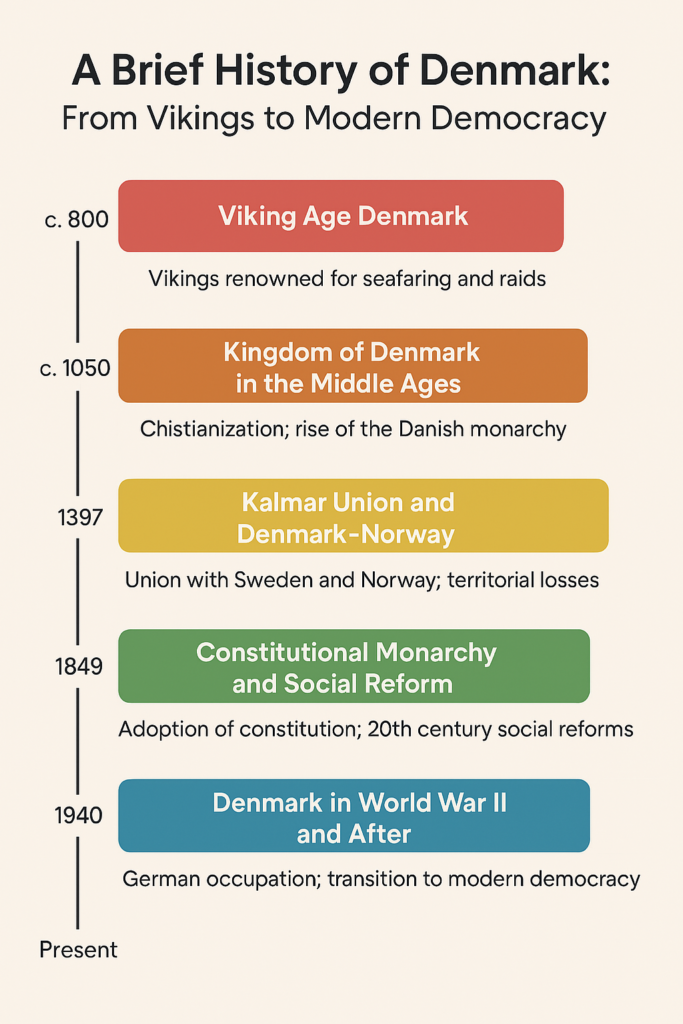
Denmark Today: A Modern, Democratic Society
Today, Denmark is known for its high quality of life, strong democratic institutions, and commitment to sustainability. While its history is rich with conflict, conquest, and reform, modern Denmark stands as a model of Scandinavian democracy.
From the Denmark Vikings to contemporary coalition governments, the country’s journey shows how a small nation can play a big role in shaping history.
Final Thoughts
Understanding the history of Denmark offers insight into how the country became a world leader in social development and democratic governance. Its transformation from Viking warrior clans to a peaceful constitutional monarchy is nothing short of remarkable.
If you’re planning to visit or move to Denmark, having a historical perspective will help you appreciate its people, values, and institutions.


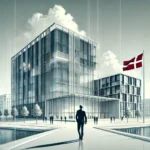
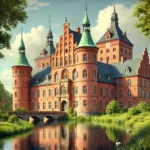
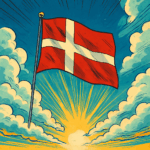
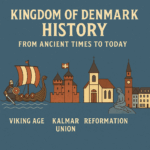
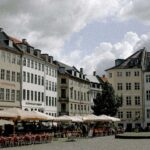
Pingback: Ice Hockey World Cup 2025: Germany vs Denmark - Quarterfinal Preview - Archysport
Pingback: Denmark Oil Spill: Beaches Closed - News Directory 3